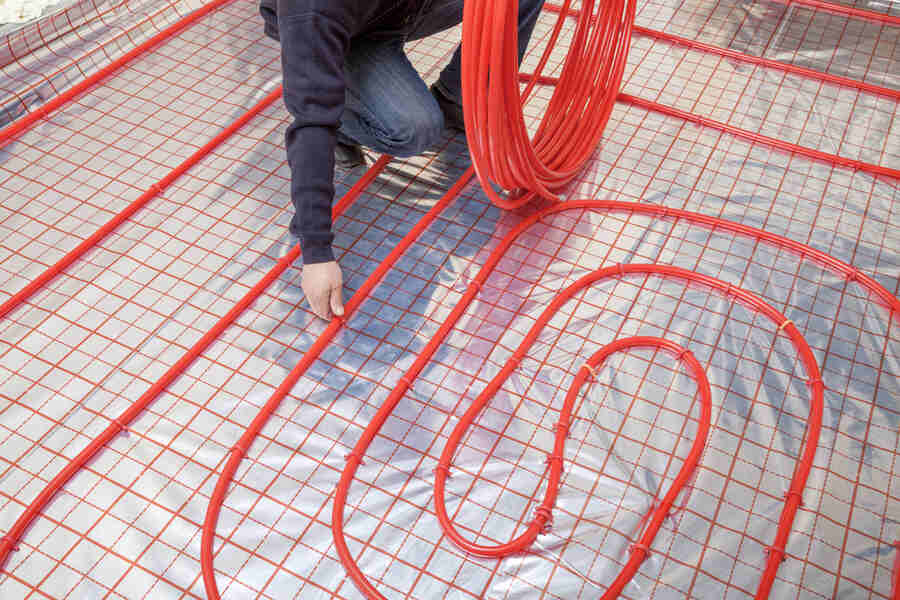Too much air in your hot water heating system and network of pipes can cause a lot of problems for homeowners. The more noticeable problem is a hissing or gurgling noise; that, though, may be the least of your problems.
Why’s that? A hot water heating system that hasn’t been recently purged may cause a bottlenecking breakdown in the ability of the heating system to do its job. This could result in poorer circulation among the system’s warren of pipes and individual radiators.
Purging Air From a Hot Water Heating System
Purging, or “bleeding,” air from a hot water system is essential for ensuring proper circulation and, in turn, a warm home. Most hot water systems are closed systems, which means that there’s always water circulating back and forth between the pipes and boiler.
Because of this closed system and the fact that most hot water heating systems don’t have an automatic purge system, you will need to purge or bleed your system every fall. Venting individual radiators and draining your boiler is essential for the proper functioning of your entire hot water heating system. Here’s how homeowners can get started:
- Locate and begin with the radiator that’s the farthest from your hot water heating system’s boiler.
- Locate the bleed valves in individual radiator units. The bleed valve is typically located at a top corner of the radiator unit itself.
- Choose the right tool for the job. Radiator bleed valves can be opened one of two ways. The easiest valves are opened with screwdrivers with a straight-edge configuration. Some valves, contrastingly, require a square-figuration and the use of a radiator key.
- After you’ve opened the valve, you’ll want to place some kind of holding receptacle (e.g., cup or bowl) under the spout. Trickles of water may come out of the spout even though your end goal is purging air from the system. This is perfectly normal and not something to panic over.
- Keep turning your straight-edged screwdriver or radiator key in the valve until you only notice water seeping out of the valve.
- Once you only have water running out of the valve, that’s an indication that the air has been purged from that individual radiator unit.
- Now, that you’ve purged the air from one radiator unit, it’s time to move upstream and do the same thing for subsequent radiators closer to your hot water heating system’s boiler.
- Once you’ve done all the individual radiator units, double back and check with the first radiator (then the second radiator, etc.) to ensure that only water is coming out of the valve.
If only water is coming out of your valve, then you’ve purged the air from your hot water heating system and should start enjoying heat this coming winter season – without any circulation problems or nasty gurgling noises in the pipes!

Frequently Asked Questions
1. Why is air in my hot water heating system a problem?
Air trapped in your hot water heating system can cause poor circulation and prevent your radiators from heating up properly. It can also lead to hissing or gurgling noises, which are signs that air is disrupting the flow of water.
2. What does purging or “bleeding” a hot water heating system mean?
Purging or bleeding your system means releasing the trapped air from your radiators and pipes to ensure proper circulation. This is essential to maintaining an efficient heating system.
3. How often should I purge my hot water heating system?
It’s recommended to purge your hot water heating system every fall before the heating season begins. This helps to avoid circulation problems and ensures your home stays warm.
4. How do I know if my radiator needs to be purged?
If you hear hissing, gurgling, or notice that parts of your radiator are cold while others are hot, it’s a clear sign that air is trapped in the system and the radiator needs to be purged.
5. Can I purge air from my system myself?
Yes, homeowners can purge air from their heating system themselves. You’ll need to locate the bleed valves on each radiator and use the appropriate tool (screwdriver or radiator key) to release the air.
6. What tools do I need to purge my radiators?
To purge your radiators, you’ll need a straight-edged screwdriver or a radiator key, depending on the type of bleed valve your radiators have. You’ll also need a cup or bowl to catch any water that may trickle out.
7. How do I start purging my radiators?
Begin with the radiator farthest from your boiler. Open the bleed valve slowly, and as air escapes, you’ll hear a hissing sound. Once water starts coming out without air bubbles, close the valve. Repeat the process for all radiators.
8. What should I do if water comes out instead of air when I open the valve?
It’s normal for a bit of water to come out during the purging process. Keep turning the valve until only water (without air bubbles) flows out. This means the air has been fully purged from that radiator.
9. Do I need to check all radiators after purging them?
Yes, after purging each radiator, it’s a good idea to double-check by going back to the first radiator and ensuring only water comes out of the valve. This confirms that your system is completely purged of air.
10. What are the benefits of purging air from my hot water heating system?
Purging air ensures that your heating system runs efficiently, keeps your home warm, and eliminates circulation issues. It also prevents noisy pipes and uneven heating, improving overall comfort during colder months.


